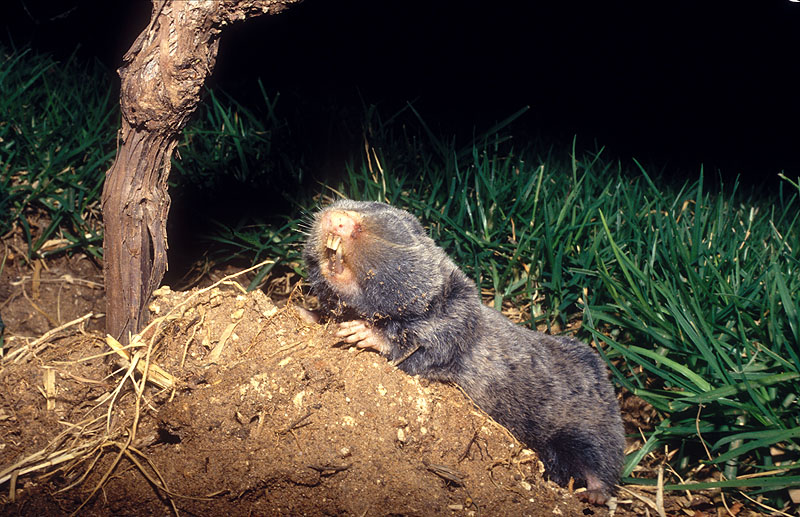- Blind mole rat
Taxobox
name = Blind mole rats
fossil_range = EarlyMiocene - Recent

image_width = 250px
image_caption = "Spalax ehrenbergi "
regnum =Animal ia
phylum =Chordata
classis =Mammal ia
ordo =Rodent ia
superfamilia =Muroidea
familia =Spalacidae
subfamilia = Spalacinae
subfamilia_authority = Gray, 1821
genus = "Spalax"
genus_authority = Guldenstaedt, 1770
subdivision_ranks =Species
subdivision = "Spalax arenarius "
"Spalax carmeli "
"Spalax ehrenbergi "
"Spalax galili "
"Spalax giganteus "
"Spalax golani "
"Spalax graecus "
"Spalax judaei "
"Spalax leucodon "
"Spalax microphthalmus "
"Spalax munzuri "
"Spalax nehringi "
"Spalax uralensis "
"Spalax zemni "
synonyms = "Nannospalax" Plamer, 1903Blind mole rats are one of many types of
rodent s that are referred to as mole rats. The hystricognathmole rat s of the familyBathyergidae are completely unrelated, whereas some other forms are also in the familySpalacidae .Zokor s (subfamilyMyospalacinae ) and root andbamboo rat s (subfamilyRhizomyinae ) are spalacids sometimes referred to as mole rats. Blind mole rats are in the familySpalacidae , but are unique enough to be given a separatesubfamily , Spalacinae.Alternate opinions on
taxonomy consider the blind mole rats to be the only members of the familySpalacidae and rank other spalacid subfamilies as full families. Other authors group all members of thesuperfamily Muroidea into a single family,Muridae .Blind mole rats are truly blind. Their very small eyes are completely covered by a layer of skin. Unlike many other
fossorial rodent s, Blind mole rats do not have enlarged front claws and do not appear to use their forearms as a primary digging tool. Digging is almost exclusively conducted using their powerful front teeth, which are separated from the rest of the mouth by a flap of skin. When a blind mole rat closes its mouth, its incisors are still on the outside. It has been suggested that blind mole rats may have evolved from spalacids that used their front limbs to dig, because their olecranon process is relatively large relative to the rest of the arm. The olecranon process is a part of theulna bone where muscles attach, and digging animals tend to have enlarged olecranon processes to provide a lot of surface for their large and powerfulmuscle s to attach.Because they are completely blind, blind mole rats have been important laboratory animals in tests on how
eye s and eyeprotein s function.The Spalacinae contains a two genera and 8
species . Some authorities treat all species as belonging to a single genus, "Spalax".References
*Jansa, S. A. and M. Weksler.
Phylogeny of muroidrodent s: relationships within and among major lineages as determined by IRBPgene sequences. Molecular Phylogenetics and Evolution, 31:256–276.*Michaux, J., A. Reyes, and F. Catzeflis. 2001. Evolutionary history of the most speciose
mammal s: molecularphylogeny of muroidrodent s. Molecular Biology and Evolution, 17:280–293.*Musser, G. G. and M. D. Carleton. 2005. Superfamily Muroidea. Pp. 894-1531 "in" Mammal Species of the World a Taxonomic and Geographic Reference. D. E. Wilson and D. M. Reeder eds. Johns Hopkins University Press, Baltimore.
*Norris, R. W., K. Y. Zhou, C. Q. Zhou, G. Yang, C. W. Kilpatrick, and R. L. Honeycutt. 2004. The phylogenetic position of the
zokor s (Myospalacinae ) and comments on the families of muroids (Rodent ia). Molecular Phylogenetics and Evolution, 31:972–978.*Nowak, R. M. 1999. Walker's
Mammal s of the World, Vol. 2. Johns Hopkins University Press, London.*Steppan, S. J., R. A. Adkins, and J. Anderson. 2004. Phylogeny and divergence date estimates of rapid radiations in muroid rodents based on multiple nuclear genes. Systematic Biology, 53:533–553.
Wikimedia Foundation. 2010.
